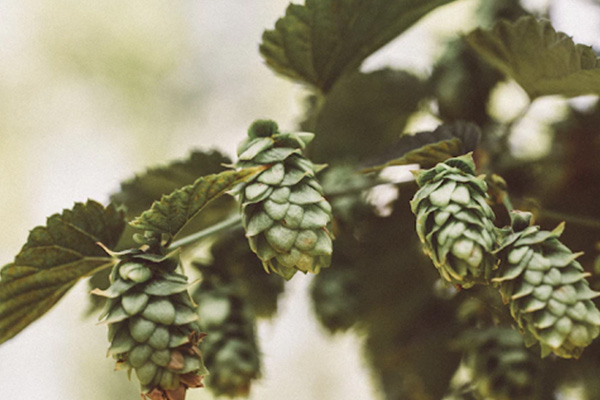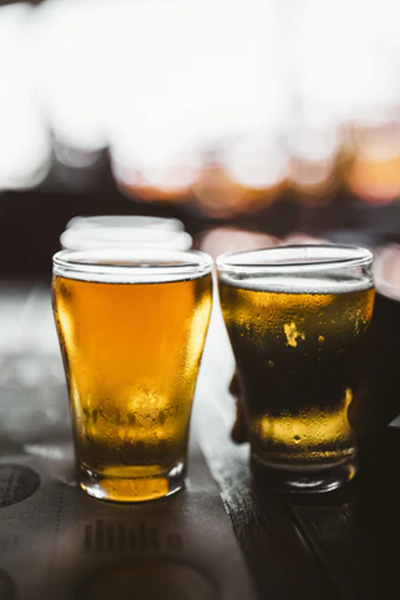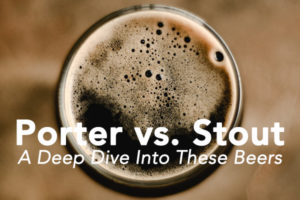Now let’s talk about the most imitated style of beer today…
…or rather, the most imitated type of lager today.
Yes, the crowd favorite Pilsner is just one type of lager beer.
While lager has been enjoyed for hundreds of years now, Pilsner is still somewhat more of a newer twist.
Also called Pils, this offspring of the popular lager is characterized by its aggressive use of hops.
And take note…
You don’t just use regular hops for your Pilsner but Saaz hops which is one of the four noble hops along with nothing but soft and pure water to create a basic tasty Pilsner.
Because of this, the Pilsner has more of a spicy note in it with a light to pale color.
A beer junkie would also know that a Pilsner shares the same fermentation process that lagers use, which is the bottom fermentation process and cold storage.
And while the yeast Saccharomyces cerevisiae has been used in brewing beer for literally a thousand years now, Pilsner uses a different kind of yeast called Saccharomyces pastorianus which feeds at the bottom of the fermentor and thrives in cold temperature.
This results in a very light, refreshing, and crisp beer with a thin mouthfeel and almost straw-like color.
The History of Pilsner Lager Beers
The now crowd favorite Pilsner can be traced back to the 19th century when a majority of beer consumers in the Bohemian city of Pilsen, in what’s now the Czech Republic, dumped whole barrels of their beers to show their dissatisfaction.
Apparently, beer was a big deal back then…
…I mean, it still is, but it was a deal big enough for the local government to open a city-owned brewery called Bürger-Brauerei Pilsen (Czech: Měšťanský pivovar Plzeň) or Citizen’s Brewery.
This brewery is now called Pilsner Urquell or “originally well”, which is kind of fitting, actually.
So what sets the Bohemian Pilsner apart from their usual german lagers?
Well, first off, it retained the same brewing and fermenting process that were used for lagers. But instead of using the usua; lager yeast, the government-employed brewer Josef Groll used the stain of yeast called Saccharomyces pastorianus.
Aside from feeding at the bottom of the fermentor in contrast to most yeast strains used for beers, it also thrives in a much cooler environment.
Groll also made use of the noble hop called Saaz, which gave the Pilsner its distinctive spicy flavor.
And lastly…
The use of soft water wrapped it all up beautifully. With only the subtlest hints of calcium and minerals used in the water, the Pilsner was able to maintain a refreshingly light taste with only a kick of spice from the hops.
The Characteristics of a Pilsner Beer
The Pilsner beer is characterized by its almost straw-like color that’s much lighter when compared side by side with its cousin the lager.
Most of the time, a good glass of pisner is gloriously crowned with a white to clear foam head as a result of its great carbonization rate.
Did you know?
The Pilsner tends to carbonate stronger than its predecessor the lager.
The aroma of the Pilsner is as light as its taste. A little hoppy but not overwhelmingly so and the taste is much more easy going than the lager, and this is just one difference among many others.
The Pilsner beer is known for its light to strong hop flavor as one of the highlights of this beer type is the Saaz hops used for it.
The Saaz hops give the Pilsner a kind of a spicy flavor but we’re not talking chili spicy here but rather just a little kick of spice with every sip.
A Pilsner can also be fruity and citrusy depending on the recipe of the craft beer made.

Types of Pilsners
Pils: Germany
The term pils is much more commonly used in Germany than Pilsner. This is to differentiate their own Pilsner to that of the Czechs’ and beer historians say, to show respect.
Compared to the original Czech Pilsner, the German Pils is crispier and even drier, thanks to its use of Germany’s mineral water and the noble European hops.
The result is a lingering bitter flavor and higher carbonation.
Pilsner: Germany, United States, and Much of the World
We knew this popular but hard to imitate beverage by its name, the Pilsner. It’s what pretty much a majority of the countries around the world call this crowd pleaser.
Thanks to German immigrants in the 19th century, the Pilsner found its way to the American soil. Today, American Pilsners are characterized by their less hoppy and less bitter flavors.
Pilsener: A spelling used for Czech brews
This Bohemian “Pilsener” originated in year 1842, with “pilsener” originally referring to the Czech Republic.
The Pilsener is known for its not too sweet and dominating malt character with a toasty, bread- or biscuit-like malty flavor. It also uses noble hops which results in a medium hoppy bitterness.
Světlé Ležák: Used exclusively in the Czech Republic
The Světlé Ležák is actually the name of a 11° Pilsner beer that’s known for its bitterness and sweet flavor.
If you’re a beer beginner and find the regular Pilsner too bitter, this might be a good introduction for you. This gem comes from the humble town of Humpolec which lies just in the middle of the Czech Republic.
Styles
Although it rose to prominence only in the 19th century, the popularity of theis bottom fermented lager is proven by the many variations that sprung up over the years. Below are the most popular types of Pilsner today.
Bohemian Pilsner
Very much the ultimate OG Pilsner, the Bohemian Pilsner was developed in 1842 using soft water, Saaz hops, and a bottom feeding strain of yeast.
The Bohemian Pilsner’s taste can range from a simple and crisp hoppy flavor to a pleasant toasty and bread-like malty taste.
American Pilsner
In the 19th century, the Pilsner was brought to the American soil by immigrants and it proved to be very popular since then.
Although it somewhat still retains some of the German Pilsner’s qualities, the American Pilsner has a much lighter to medium hop flavor and sometimes, up to 25% corn or rice.

American Imperial Pilsner
Everything’s bigger in America…and true enough, the American imperial Pilsner is a result of the craft brewers’ doing by amping the flavor up and giving this Pilsner a bolder flavor with a more intense bitterness and a more pronounced malty taste.
How to Serve Pilsner?
The Pilsner is most commonly served in a tall and slim Pilsner glass. It’s said that a narrow glass can preserve its carbonation more than a shorter one. So make sure stock up if you plan on brewing your own at home with an all-in-1 beer brewing system 🙂
A tulip glass or even a wine glass is also used as a vessel for the Pilsner in a more formal setting. Just make sure to remember to resist the urge to swirl the beer around in your glass like wine to preserve the carbonation and keep the Pilsner from getting flat.
Food Pairing
If you love eating rich, fatty, or flavorful foods, then you’ll be happy to know that Pilsner is best paired with these kinds of snacks.
A little spicy and crisp, the Pilsner goes well with foods such as burgers, pizzas, tacos, and saucy meat dishes as its crisp quality can act as a great palette cleanser.
You can also gulp it down with the more subdued foods such as shellfishes and cheeses as its spicy notes can add the thrill these delicate foods may need.
Best Brands
Below are the best brands of Pilsners that we’ve tried in no particular order (all equally remarkable!).
- Pilsner Urquell
- Seedstock Czech Pilsner
- Live Oak Pilz
- Station 26 Saaz Pilsner
- Jever Pilsner
- Victory Prima Pils
- Heater Allen Pils
- Firestone Walker Pivo Pils
Conclusion: What Kind of Beer Style is Pilsner?
What started out as a solution to the citizens’ dissatisfaction turned into a worldwide sensation that’s now being imitated by many.
Noble hops, a thoughtful addition of soft water, Pilsner yeast and meticulous fermentation and storage processes are the stuff that make up a genuine Pilsner-nothing more and nothing less…except, of course, for the fun additions.
It can be both an adventurous and a laid back beer option and that may explain why most beer nerds’ fridges are stacked with cans after cans of good Pilsners.
After all…
What could be better than a flexible and approachable beverage after a long day?
How about you? What’s your favorite Pilsner flavor and brand?
Let me know on our social media channels and let’s discuss!
For more fun beer trivias, hacks, and tips, you can also sign up for free to receive our newsletters!




